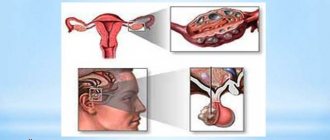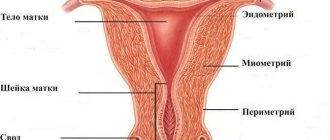During one menstruation, a woman loses up to 150 ml of blood. Depending on the characteristics of the body and the influence of external factors, this indicator changes. If the volume of blood released is less than 50 ml, then such periods are considered scanty. This is due to pathology and external influences. Only a doctor can identify the true causes of scanty periods.
Secondary hypomenstrual syndrome
Many women who have heard about scanty periods are interested in what kind of discharge it is and how it differs from normal menstruation. In fact, understanding this issue is quite simple.
Normally, the cycle is at least 21 and maximum 35 days. The duration of menstruation varies from three to five days. During this period, 50–150 ml of blood leaves the body.
If menstruation has become less abundant than usual, and its volume differs from the norm - less than 50 ml, then a diagnosis of “hypomenorrhea” is made, which is considered a cycle disorder. As a rule, during menstruation there is very little discharge - just a few drops. They often have a smearing character and are brown, black or extremely light in color.
Secondary hypomenstrual syndrome is a condition in which scanty periods are observed. They go less, become short and may stop on the third day. In this case, the menstruation that appears differs from the previous one. The early menstruation was within the normal range, but the next ones dramatically changed their character. The reasons why blood loss is 30-50 ml during critical days are physiological and pathological.
To correctly assess hypomenstrual syndrome, it is necessary to clearly understand how much blood a woman normally loses during menstruation. Read more about this in our article on the website.
What is considered normal and what is pathology?
Many women do not think, do not pay attention, do not attach much importance to how menstruation occurs, whether the cycle is regular and what the discharge is like. However, if a woman monitors her health and plans to give birth to a child, especially if pregnancy does not occur for a long time, she should know that the nature of menstrual flow is a fairly significant indicator of possible disorders, diseases, and deviations in the reproductive function of the body.
Normally, menstruation should proceed as follows; doctors regard any deviation from these norms as hypomenstrual syndrome or menstrual dysfunction:
- menstruation should be either slightly painful or painless at all
- should last at least 3-5 days
- the interval may be normal within 21-35 days
- The volume of blood released is considered normal within 50-150 ml
To determine the “normality” of the menstrual cycle, especially if a woman is planning a pregnancy, it is advisable to keep a kind of observation diary, make a sign where to write down the date of menstruation, the duration of the cycle, the duration of the bleeding itself, the nature of the discharge, and you can also keep a table for measuring basal temperature, which also is an excellent way to determine normal or abnormal ovarian function and helps for those who are preparing for pregnancy.
Hypomenorrhea in medicine is usually called not heavy periods, having only traces of blood or drops of blood from light brown to dark brown, which are considered a pathology of menstrual function. The only exception is the 2 periods in a woman’s life when the reasons for scanty periods are the formation or decline of the menstrual cycle, when ovulation occurs irregularly.
When a girl just begins menstruation, usually the first periods are scanty, but over the course of a year the cycle gradually becomes established, normalizes, and after a year should become regular. During the first year of menstruation, as well as in cases of menstrual dysfunction, menstruation can be:
- rare - opsomenorea, when the cycle is 1.5 -2 months
- scanty - 50 ml. and less - hypomenorrhea
- shortened - oligomenorrhea, when menstruation ends by the 3rd day
- not constant, but 2-4 times a year - spanimenorrhea
Also, scanty periods are not considered a pathology during the period when a woman’s reproductive function declines - premenopause, which is a natural age-related hormonal change and is not considered a sign of any disease. The decline of ovarian function usually begins in women after 45 years of age, but there are rare cases when it occurs much earlier, around 38-40 years of age.
Hypomenorrhea in gynecology is usually divided into:
- primary, when the girl has never had normal menstruation
- secondary, when a woman has always had normal bleeding, but for certain reasons her periods become scanty.
Primary hypomenstrual syndrome can occur in adolescents with congenital pathology of the genital organs, which is quite rare. When girls have their first scanty periods, the cause may be underdevelopment or abnormal development of the female genital organs, and it may also be a variant of the norm and within several cycles menstruation becomes normal (see reasons for the absence of menstruation).
Functional reasons
Scanty periods are often observed due to disturbances in the functioning of the ovaries or pituitary gland, which are responsible for the reproductive function. Failures of the endocrine system can also lead to similar changes in the menstrual cycle.
Ovarian diseases
Dysfunction of the ovaries has a direct impact on menstruation. The cycle becomes shorter, menstruation occurs without blood or with a minimal amount of brown discharge. The secretion of hormones is disrupted, and for this reason, a change in the nature of critical days is observed.
Impaired ovarian function can be caused by various diseases, including inflammatory processes, polycystic disease (multiple cysts in the ovaries) and tuberculosis, which affects these organs.
Thyroid diseases
Pathologies such as diabetes mellitus and hyperfunction of the thyroid gland often lead to a decrease in the volume of blood lost during menstruation. In addition, the following clinical manifestations are noted:
- weakness;
- causeless weight loss;
- excessive sweating and extreme thirst;
- depression;
- itching
If your periods are not abundant and are accompanied by such symptoms, you need to go for a consultation with an endocrinologist.
Pituitary gland diseases
If there are abnormalities in the pituitary gland, which is responsible for regulating the menstrual cycle, very scanty periods are observed. Hormones are produced in an inappropriate amount, and as a consequence of this - insufficient uterine blood circulation and abnormal structure of the endometrium. For this reason, heavy periods are abruptly replaced by minor discharge.
After scraping
Any intrauterine intervention - abortion (complications), diagnostic curettage, removal of polyps, etc. can cause scanty periods. Since such an intervention disrupts the hormonal balance and leads to endometrial inferiority. If, in addition to menstrual irregularities, an unpleasant odor, pain, or fever also appears after curettage, the woman should urgently consult a doctor, since the cause may be an inflammatory process due to unsuccessful surgical manipulation, incomplete removal of the membranes, as well as a possible infectious-inflammatory process , which began after an abortion or diagnostic curettage.
Organic causes
The causes of scanty menstruation may lie in various pathologies affecting internal organs and systems. There is a certain relationship between the body as a whole and the reproductive system.
Thus, scanty periods are often caused by diseases or infections affecting the genital organs, obesity and liver disease.
Diseases of the genital organs
Weak periods are observed with the development of diseases of the uterus and other pathologies affecting the reproductive system, such as:
- Endometriosis. The structure of the mucous membrane changes. Over time, the vagina, cervix and abdominal cavity are affected.
- Endometrial hyperplasia. The mucous membrane of the uterus grows into the muscular walls, as a result, small vessels are damaged and a discharge similar to menstruation appears.
- Polycystic ovary syndrome. Cysts form on these organs, which causes hormonal imbalances. As a consequence of the development of the disease, women's menstrual flow becomes insignificant and irregular.
- The presence of polyps in the uterus. Growths form on the endometrium caused by hormonal imbalances. Initially, scanty discharge appears, which abruptly turns into bleeding.
- Infantilism of the reproductive system organs. In addition to the fact that the amount of discharge is significantly reduced, women experience severe stomach pain during menstrual periods.
Inflammation of the genital organs
In the presence of an inflammatory process in the genital area, reproductive function disorders often occur. The factor that provokes the penetration of infection into the genitals is non-compliance with the rules of intimate hygiene, unprotected sexual intercourse or hypothermia.
With sexually transmitted infections such as colpitis, vulvitis, cervicitis, candidiasis and vulvovaginitis, the volume of discharge does not change, but only at the early stage of the disease. If the uterus, tubes and ovaries are damaged, menstruation becomes light and painful.
Symptoms of the inflammatory process:
- pain in the lower abdomen, independent of the menstrual cycle;
- scanty discharge (their color, consistency and smell change);
- itching;
- hyperthermia;
- vomiting and nausea;
- pain in the lumbar region.
Inflammation can develop against the background of decreased immunity, taking antibiotics, excessive fatigue and emotional stress.
Obesity
Weak discharge is often observed in overweight women. This is due to the fact that hormones - estrogens - are deposited in fatty tissues. When too many of them accumulate, the activity of the endocrine system is disrupted, and as a result - a malfunction of the ovaries and adrenal glands.
Changes in hormone levels lead to changes in the frequency and nature of bleeding. They become scanty, sometimes accompanied by spasmodic pain and nausea.
Liver diseases
Liver pathologies can cause hypomenorrhea. In this case, long, scanty periods are observed. Nosebleeds are often observed during menstrual periods. In this case, a mandatory medical consultation is required. If a woman’s menstruation is scanty and accompanied by other unpleasant symptoms, then she immediately needs to go to a gynecologist for help.
Hypomenorrhea
A frequent cycle disorder is hypomenorrhea, or scanty periods, when blood discharge becomes weak. It is most often accompanied by another pathology - oligomenorrhea, when menstruation lasts fewer days than usual, the duration of bleeding during menstruation is noticeably reduced. Menstruation is considered scanty if the blood loss during all days of menstruation is no more than 50 ml.
For scanty menstruation:
- change color: either too light or dark, brown in the form of strokes;
- can last the usual number of days, but more often they last a shorter period, 1-2 days.
Hypomenorrhea is most often caused by some disease; there are many reasons for scanty periods, and most of them require therapy, since they provoke dysfunction of the reproductive organs and other systems in the body.
Reason No. 1: Underweight and overweight
One category of women carefully looks after themselves and tries to stay in shape. Diets, exercises in fitness centers, gyms and swimming pools are used. The flow of physical activity on an organism exhausted by diets forces it to save energy on everything, including the production of hormones. As a result, menstruation lasts for few days, and they are very scanty. This is a kind of body response to shock from exercise and changes in diet.
Experts have proven that the menstrual cycle and muscle mass in women are connected: muscular representatives of the fair sex often experience scanty periods.
The reason that little blood is released during menstruation and that they have become very short may be excess weight. This is a different category of women - those who are accustomed to eating improperly or who are prone to excess weight due to any concomitant diseases. Fat tissue accumulates estrogen, which disrupts the cycle, leading to scanty menstruation: they become weak, in the form of rare spotting.
Reason #2: Polycystic and other ovarian diseases
One of the most common reasons why little blood is released during menstruation is disturbances in the functioning of the ovaries. It is quite easy to establish this etiology using a blood test, including determining the level of hormones secreted by the body. Typically, the doctor checks the amount of thyroid hormone, insulin, estrogen, androgens, and progesterone. Based on the results, the specialist will determine the likelihood that the woman has a disease such as polycystic ovary syndrome, which is characterized by irregular and scanty periods.
To accurately establish the diagnosis, it is necessary to conduct an ultrasound, which will determine the size of each ovary, the thickness of the endometrium, the condition of the follicles and the presence of their growth, the presence or absence of ovulation, and other pathologies of the reproductive organs caused by disturbances in the functioning of the thyroid gland. If this pathology is not diagnosed in time, the disease can lead to infertility.
With polycystic disease and other hormonal imbalances, in addition to scanty periods, increased oily skin and acne, excess body hair, and weight gain are observed.
This same group of reasons that cause changes in the amount of blood released during menstruation includes disturbances in the functioning of the pituitary gland.
Reason #3: Tuberculosis and other infections
Another very serious reason why menstruation became scanty and began to last several days less is tuberculosis, which affected the patient’s genitals. In addition, other infectious diseases and inflammatory processes in the body, especially in the genitourinary system, can affect the menstrual cycle and significantly harm it. They entail inferiority of the uterine mucosa, which leads to scanty menstruation. Therefore, if a woman notices scanty discharge instead of menstruation, it is important to consult a doctor in order to diagnose such diseases and receive timely treatment.
Reason #4: Abortions and other surgeries
Scanty discharge once a month can be caused by problems with the ovaries. Frequent abortions can easily provoke their improper functioning, since they wreak havoc on the production of hormones in the body, interfering with proper blood circulation in the uterus. Curettage to terminate a pregnancy injures this organ, which also disrupts the menstrual cycle and leads to scanty periods.
The functioning of the reproductive system can also be damaged after other surgical procedures: after operations to remove polyps and fibroids, the quality of the endometrium changes significantly and for the worse; it is damaged, which affects the quantitative and qualitative characteristics of menstruation.
Reason #5: Gynecological diseases
When scanty periods appear, it is imperative to pay attention to the condition of the body, since they can be symptoms of other gynecological pathologies that require treatment and sometimes surgical intervention: these are diseases of the pelvic organs, the formation of polyps or fibroids in the uterus, the development of diseases transmitted through sexual contact .
Reason No. 6: Harmful and hard work
Hypomenorrhea can also occur in completely healthy women whose work involves:
- with heavy physical labor, heavy loads;
- with toxic, harmful substances;
- with radioactive radiation or chemicals.
These working conditions interfere with the proper functioning of the hormonal system to such an extent that they can prevent the onset of ovulation, increasing the concentration of hormones in the body that interfere with the proper functioning of the reproductive organs. This leads to scanty and short periods.
Reason #7: Incipient miscarriage
A woman may not know that she is pregnant, so the onset of menstruation will not alert her, but the arrival of scanty menstruation should be a signal of alarm: small spotting during pregnancy, which can be confused with menstruation, is a symptom of spontaneous abortion, placental abruption , which is very dangerous for the fetus. Such bleeding is an indication for urgent hospitalization of a woman for pregnancy-preserving therapy.
Reason #8: Nervous condition
Frequent stress and being under constant tension can easily cause hypomenorrhea, because such conditions overwork the body and deplete its strength. Other diseases of the nervous system can also cause scanty periods.
Mental trauma, strong emotional experiences and disorders affect the quantitative characteristics of menstruation. Climate changes and prolonged severe pain, which affect the general condition of the body, lead to scanty periods.
Reason #9: Drugs
Scanty periods appear in women who have chosen the wrong hormonal medications, for example, contraceptives, which should only be done with a doctor. Taking any contraceptives entails a decrease in bleeding during menstruation.
Reason #10: Immunity
Although not common, the cause of hypomenorrhea is anemia and a lack of vitamins in a woman’s body, especially iron. Irregularities in the functioning of the immune system can also lead to scanty periods.
Reason #11: Anomalies
Scanty menstruation is not uncommon in teenage girls who have a delay in sexual development, and they may also be diagnosed with a delay in general development. This leads to abnormalities in the functioning of the reproductive system, which becomes the cause of hypomenorrhea.
Reason No. 12: Heredity and only
This is one of the most harmless reasons why a woman may have scanty periods, and such a phenomenon becomes the norm, since hypomenorrhea is genetically embedded in the body. A hereditary tendency to scanty menstruation is not a pathology and is most often observed in other women in the patient’s family: mother and sisters.
Iatrogenic causes
Scanty periods can appear after taking medications and as a result of medical intervention. The reason for the change in the nature of discharge often lies in the use of hormonal contraceptives, abortive measures and other special procedures.
Taking medications
One of the common causes of scanty menstruation is the use of oral contraceptives. Such changes are considered normal in most cases, but should be monitored by a doctor.
Little discharge is also observed when taking antibiotics and hormonal drugs. As a rule, after their cancellation, the cycle and volume of menstruation become the same.
Medical interventions
As a result of operations in the uterine area and frequent curettages, scars form, and the area of the endometrium that functions becomes smaller. No matter how gentle modern technologies are, tissue injury and thinning of the uterine epithelium cannot be ruled out. As a result, the volume of discharge is reduced. Menstruation occurs without blood, or rather with minor losses. With properly prescribed therapy, damage can most often be restored.
Main causes of hypomenorrhea
The most serious and common pathological cause of the development of hypomenorrhea in women of reproductive age is dysfunction of the ovaries and pituitary gland, which are regulators of menstrual function. For example, pituitary insufficiency, Sheehan syndrome, can lead to a complete absence of menstruation (amenorrhea) or other menstrual dysfunction.
Ovarian dysfunction
Various inflammatory processes, hormonal imbalances, and external factors can lead to ovarian dysfunction:
Various inflammatory diseases of the female genital organs
These are inflammations of the uterine appendages - adneskitis (salpingoophoritis), inflammation of the ovaries - oophoritis, caused by various pathogens, STIs. They can occur from severe hypothermia, frequent improper douching (douching is harmful or beneficial), and other infectious diseases that lead to the transfer of the pathogen through the bloodstream from other organs to the female genital organs.
- Psychological fatigue, nervous strain, irrational rest and work schedule, physical and psychological fatigue.
- Mini-abortion, medical abortion, spontaneous miscarriage, especially during the first pregnancy, when sudden hormonal changes occur - all this provokes the development of stable ovarian dysfunction.
- Underdevelopment of the genital organs, abnormal development of the uterus and uterine appendages.
- External factors such as taking certain medications, radiation damage, climate change, excessive exposure to sunlight or abuse of solariums.
- Incorrectly selected oral contraceptives or their long-term use contributes to weakening of ovarian function (see the negative consequences of taking oral contraceptives in the article on birth control pills)
- Obesity, diabetes mellitus, diseases of the adrenal glands and thyroid gland can cause ovarian dysfunction.
Other causes affecting the menstrual cycle
The explanation for why periods have become scanty could be various external factors:
- frequent stress;
- poor nutrition;
- climate change;
- severe physical fatigue;
- mental stress;
- sedentary lifestyle.
Sometimes women experience scanty periods after 40 years, but they do not always indicate the presence of pathology. We recommend reading more about this in a separate article on our website.
Pathological condition
If a woman does not belong to any of the categories mentioned above, and the situation is such that menstruation has become less abundant, and plus shortened. What's behind this? What to do?
Hypomenorrhea is the name given to scanty menstruation. In this case, the amount of blood lost does not exceed 50 ml per day. In addition, quite often hypomenorrhea goes along with another problem - oligomenorrhea (short duration of bleeding).
The source most often becomes a dysfunction of the ovaries and pituitary gland, the main controls of the regularity of the menstrual cycle. Or ovarian dysfunction, caused by various hormonal imbalances, inflammatory processes, and external factors.
What else could be the cause of scanty menstruation:
- Surgery on the genital organs: abortion, cleansing, removal of polyps, etc.;
- Various tumor growths on different organs of the girl: fibroids, fibroids, cervical cancer, tumors of the uterus or ovary and others.
- Endocrine disorders, and, as is known, the thyroid gland plays an important role in the development of the correct menstrual cycle;
- Diabetes;
- Gynecological diseases: polycystic ovary syndrome, sexually transmitted infections;
- Tuberculosis and other infections.
That is why, if problems arise in the reproductive system, you need to visit a gynecologist. He is the only one who can determine the cause of hypomenorrhea and eliminate it.
Treatment
As soon as scanty periods appear, you should consult a doctor who will carry out the necessary diagnostic procedures and prescribe adequate therapy. To determine the dangers of changes in the menstrual cycle and the nature of discharge, a visual examination and additional research are necessary .
The gynecologist will examine the medical history, basal temperature chart, hormone levels (using blood and urine tests), and diagnose sexually transmitted infections (they are determined using a smear, bacterial culture and PRC). It is possible that you will need to do an ultrasound and take a tissue sample for a subsequent biopsy.
Treatment of scanty periods directly depends on the diagnostic results. In case of malnutrition, lack of psycho-emotional balance and excessive physical exertion, the provoking factor is first eliminated. In addition, vitamin complexes, hormonal and antimicrobial agents are prescribed.
If a pathology is detected, in addition to general strengthening actions, therapy for the underlying disease is performed. Additionally, physiotherapeutic and psychotherapeutic treatment may be required, with the help of which functional disorders can be eliminated.
A change in the volume of menstrual flow does not always indicate the development of pathology, but in any case, such disturbances cannot be ignored. Only after diagnostics can the cause of these changes be identified and the cycle normalized.
Each cause has its own therapy
There are many reasons for scanty periods, and if they are not natural (this is not the first stage of puberty, not a harbinger of menopause, and not the body’s recovery after pregnancy and lactation), then a woman should consult a doctor to determine the factors influencing the disruption of the menstrual cycle.
- Natural causes of scanty periods do not require any treatment.
- If the issue is a hormonal imbalance, disruption of the thyroid gland, ovaries, or pituitary gland, then the doctor, after conducting tests, will prescribe hormonal therapy.
- When neurological and psychological problems are identified, the specialist will help the woman understand the reasons in order to return her to emotional calm and a healthy lifestyle.
Read
Also:
- Why do you not have periods regularly and what to do? Unstable menstrual cycle
- How to delay menstruation without harm to health using traditional and folk medicine?
- If your period doesn't end, what to do?
- Reasons why periods are delayed, what delay is considered normal
Treatment for hypomenorrhea
Scanty menstruation is not a disease, but a symptom, so therapy can only be prescribed individually after diagnosis. The following measures may be required in different cases:
- With sexual infantilism, long-term hormonal therapy with the artificial use of necessary substances is required. For endocrine disorders, drugs of this type are prescribed based on an analysis of hormone levels.
- Inflammatory processes are treated comprehensively. Antibiotics eliminate infection, antihistamines relieve tissue swelling, and antispasmodics and anti-inflammatory drugs are also used.
- For obesity and scanty menstruation, diet and weight loss are necessarily recommended; without this, it is impossible to recover. The lack of kilograms is more difficult to compensate for, sometimes hospitalization and the help of a psychotherapist are required.
- Severe stress and depression, which lead to hormonal imbalances and cycle failure, require the help of a psychotherapist.
- Tumors in the uterus, ovarian cysts, and formations in the cervical canal may be an indication for surgery.
Traditional methods of treating cycle failure
Alternative medicine offers products with natural hormones that normalize their levels in a woman’s body, and therefore bring menstruation back to normal. They use sage, boron uterus, red brush, and raspberries in courses during certain periods of the cycle. The therapy is really effective, but first you need to understand why your periods have become scanty.
Attention! Self-medication with the use of herbal or medicinal preparations that affect hormonal levels is very dangerous. As a result, patients suffer a bunch of complications.
Menstruation during pregnancy
Conception occurs if fertilization of a mature egg is observed in the second half of the cycle. After conception, the level of estrogen concentration in the blood drops, and the level of progesterone begins to increase. In this way, the structure of the uterine mucosa is preserved and an obstacle to endometrial rejection is formed. Therefore, normally there should be no menstruation during pregnancy.
However, in some cases, scanty periods are still present during pregnancy. Sometimes even a woman does not suspect that she is pregnant, because she thinks that her period has begun.
There are many reasons for menstruation during pregnancy.
It is important to consult a doctor in time, since bleeding during pregnancy may indicate serious problems during pregnancy.
Lack of progesterone
Insufficient production of progesterone may be associated with the physiological characteristics of a woman’s body. In such cases, partial rejection of the mucous membrane occurs.
The danger is that along with the rejection of the endometrium, the fetus may also be rejected, which will terminate the pregnancy at the very beginning.
If a woman notices that her periods are scanty for several months in a row, and she is unable to get pregnant, then she needs to visit a gynecologist and get tested for progesterone. Thanks to timely adjustment of progesterone levels, the possibility of maintaining pregnancy increases.
As a result of excess production of androgens (male sex hormones), pregnancy termination and scanty periods may occur.
Ectopic pregnancy
This condition is dangerous not only for the unborn child, but also for the woman. In an ectopic pregnancy, the fertilized egg is implanted not in the uterine cavity, but outside it, usually in the fallopian tubes.
With an ectopic pregnancy, a woman may experience scanty periods due to shedding of the uterine lining.
In addition to bloody discharge, a woman may feel pain in the lower abdomen, which has a pulling character and increases every day.
It is important to detect the VB in time so that the pipe does not have to be removed
Deviations in fetal development
Due to developmental abnormalities, the fetus simply cannot attach to the uterine cavity. This causes partial rejection of the endometrium along with the fertilized egg. This can cause spotting and nagging pain in the lower abdomen.
If a woman takes a test during this period and then immediately consults a doctor, then at this stage it is sometimes possible to maintain a developing pregnancy.
Fertilization of two eggs at once
When two dominant follicles mature in a woman’s body, and after fertilization one of the embryos is rejected due to unsuccessful attachment in the uterine cavity or due to improper development, scanty menstruation-like discharge may appear.
Examination and treatment if necessary
If the discharge has become small in volume, has a strange color or even smell, you should urgently contact a specialist. The reason may not be serious, but an examination is necessary to understand. Some illnesses can lead to the inability to bear a child or even infertility.
Doctors say that the signs of early cancer are very similar to the symptoms of ovarian dysfunction. Cancer of the uterus and ovaries is treatable, but for a positive effect it is necessary to diagnose the disease at an early stage. Therefore, it is so important to go to the hospital in a timely manner for examination.
To make a diagnosis, the following procedures will be carried out : examination by a doctor, smears taken for culture, most likely, the doctor will prescribe a urine and blood test. Ultrasound is also prescribed for a reliable examination and diagnosis.
Treatment will depend on the diagnosis. If the cause is hormonal imbalance, medications will be prescribed to help normalize them. Antifungal drugs, antibiotics or antiphlogistic agents may also be prescribed during treatment.
If the cause of scanty periods is psychological problems , positive emotions, frequent walks in the fresh air, and proper and balanced nutrition will serve as a cure. If the patient suffers from bad habits, it is worth giving them up. Smoking, for example, has an extremely negative impact on women's health.
Types of violations
A menstrual cycle is considered a violation if its duration increases by more than 7 days or the interval between flows is reduced by a week. Moreover, they talk about diseases if such phenomena become systematic.
Deviations in the normal course of menstruation are divided into several categories:
- Amenorrhea. This is when menstruation is absent for several cycles. Amenorrhea can be primary, when there is no discharge until the age of 16, but the signs of puberty are obvious. It is called secondary when menstruation begins, but disappears for a long time.
- Dysmenorrhea. Deviations in menstruation can occur in any direction - reduction or increase. Dysmenorrhea can appear regardless of age. However, if the cyclicity is just beginning and is not fully regulated (adolescence, postpartum periods), then this does not apply to pathologies.
- Oligomenorrhea, when menstruation is very infrequent. Bleeding lasts no more than two days, there is little discharge. Primary oligomenorrhea occurs due to underdevelopment of the uterus, secondary - due to abnormalities in the hypothalamic-pituitary system, tumors, and after infectious diseases. Usually, menstrual irregularities are typical for overweight women. Problems with conception often occur.
- Hypomenorrhea. In this case, a scant amount of discharge is observed - blood loss is less than 50 ml. Menstruation is delayed and accompanied by negative symptoms - headache, nausea, lack of appetite, weakness in the legs, etc. The cause of hypomenorrhea can be dysfunction of the ovaries, pituitary gland, changes in the uterine mucosa.
- Proyomenorrhea. This is a reduction in the period to 21 days. Most often, periods are short - they last only a couple of days. Most often the discharge is small, but it can also be copious. Proyomenorrhea is often accompanied by ovulation, sometimes anovulatory periods.
- Opsomenorrhea is when the cycle increases to at least 35 days (but not more than 3 months). At the same time, the discharge is scanty and menstruation is short. This is often accompanied by infertility. Women with opsomenorrhea tend to be obese, may have some masculine features, and often suffer from acne.
- Polymenorrhea. Bleeding lasts for more than a week.
- Hypermenorrhea. In this case, the volume of discharge increases greatly, but the duration of menstruation remains normal. This can be caused by gynecological diseases, a decrease in platelets in the blood, polyps, and endocrine diseases.
- Menorrhagia. The duration of menstruation increases, there is a lot of discharge.
- Metrorrhagia. Characterized by severe uterine bleeding caused by tumors, diseases, and lack of ovulation.
Menstrual irregularities are divided into several categories depending on the causes:
- Hypothalomic abnormalities are caused by infectious-toxic injuries, injuries, and mental disorders. At the same time, the concentration of gonadotropic hormones remains normal, but luteinizing hormones become less. The reactivity of the uterus decreases, and secondary amenorrhea appears. Atrophic changes can be detected in the genitals.
- Pituitary diseases develop due to a deficiency of gonadotropic hormones. This happens during pregnancy and childbirth. Further, atrophy of the ovaries and external genitalia, and hair loss may occur. Menstrual irregularities first manifest themselves in the form of hypo- and oligomenorrhea, then amenorrhea. Deviations are provoked by a pituitary tumor, Itsenko-Cushing's disease, and hyperplasia.
- Ovarial. This menstrual cycle disorder can be hyper- and hypohormonal and is divided into hyper-estrogenic and progesterogenic. They appear as a result of a follicular cyst, purulent salpingo-oophoritis. Early atresia and scarring leads to hypo- and amenorrhea.
- A large amount of progesterone is released. The cause may be luteal cysts or persistent corpus luteum (but this is rare). The structure of the endometrium is disrupted and if not restored, this leads to menorrhagia.
- Another menstrual cycle disorder is ovarian failure. They can be primary or secondary, when there is a deficiency of gonadotropic hormones. The causes may be mental trauma or anatomical abnormalities.
Most often, disruptions in menstruation occur against the background of gynecological diseases - vaginal fistulas, tumors, salpingo-oophoritis, endometritis. The cycle gets disrupted due to anemia, vitamin deficiency, infectious diseases, when hard work is accompanied by poor nutrition. The classification of disorders includes damage to the central nervous system, endocrine and reproductive systems, malfunctions of internal organs caused by chromosomal and genetic abnormalities.
What signs may accompany scanty menstruation?
There can be many reasons for scanty and short periods. Even if menstruation is extremely scanty, it can occur unnoticed by a woman, and, on the contrary, can also make itself felt with accompanying symptoms. There may also be fluctuations in terms of the duration of discharge and its intensity. Most often this happens after the fact of the delay; during this period, pronounced PMS forms, and ailments also arise:
- unpleasant pain in the lower abdomen;
- spastic uterine contractions;
- unpleasant pain in the lumbar or chest area;
- dizziness;
- problems with bowel function;
- blood from the nose.
These reasons entail a decrease in female libido and other complications in the body of the fair sex. If your periods were normal at first and then became scanty, this should alert you and force you to contact your doctor.
Treatment of scanty periods
Treatment of hypomenorrhea depends on the cause that caused it.
If gynecological diseases are the causative factors in the occurrence of scanty periods, then therapy is carried out by a gynecologist. In case of tuberculosis infection, treatment is carried out by a TB doctor. In case of endocrine pathologies, treatment is carried out by an endocrinologist; in cases of mental disorders, joint supervision of the patient by a gynecologist and a psychologist is recommended, and, if indicated, by a psychiatrist.
Treatment of hypomenorrhea lasts for more than one month.
Dissection of intrauterine synechiae, fusion of the cervical canal and emptying of hematometers is carried out by hysteroscopy or hysteroresectoscopy under anesthesia. After the surgical stage of dissection of adhesions, the stage of hormonal therapy necessarily follows. A combination of estrogens and gestagens (not COCs) is usually prescribed. Against the background of hormone replacement therapy, it is necessary to achieve the growth of normal endometrium.
For PCOS, the treatment regimen includes weight loss, taking medications that improve insulin sensitivity, correction of hyperandrogenism, and surgery (incisions on the ovaries, making it possible to release and ovulate eggs). Surgical treatment is performed for infertility and the patient’s desire to conceive.
In case of hyperprolactinemia, its correction is carried out (drug “bromocriptine”, “Dostinex”). If there is a lack of thyroid hormones, they are introduced into the body for replacement purposes.
Replacement therapy with sex hormones is also carried out for the syndrome of exhausted ovaries and resistant ovaries. Without the introduction of hormonal drugs from the outside, a woman’s body will develop premature menopause.
For chronic adnexitis and endometritis, antibiotics and anti-inflammatory drugs, resorption therapy and physiotherapy are prescribed. In chronic endometritis, endometrial insufficiency is usually always present. In order for a woman to be able to menstruate and bear a child in the future, rehabilitation is prescribed after anti-inflammatory therapy. Its goal is to improve blood flow in the pelvis, restore the functional layer of the uterus, and prevent sclerotic changes in the ovaries after inflammation. The woman is recommended to undergo laser blood purification, ozone therapy, and stimulation of endometrial growth through the use of hormonal drugs and stem cell preparations.
If you are overweight or underweight, it is corrected and vitamins are prescribed according to the phases of the menstrual cycle.
Why periods go poorly: reasons for weak and scanty discharge
You can visit your local obstetrician-gynecologist or go to an appointment with a specialist in a private paid clinic.
Natural (physiological) causes
Physiological and non-health reasons why periods have become scanty or stopped altogether include:
- Completed breastfeeding. The postpartum period is often characterized by long intermenstrual periods and changes in the volume and nature of blood released during this time. The reason for this is hormonal levels, the recovery of which can take quite a long period. The first bleeding is observed in a woman who has given birth and is not breastfeeding immediately after the end of lochia. In a mother who is fully breastfeeding, a cycle may appear only after the complete completion of lactation. For mothers whose children are mixed-fed, menstruation begins 3-4 months after birth. The duration of the nursing cycle can vary from 26 to 40 days, and this is not considered a pathology.
- Pregnancy. Science knows of cases, and there are quite a few of them, when a woman carrying a child does not stop menstruating until she gives birth. However, this is not the usual bleeding, requiring the replacement of 3-4 pads per day. A small amount of bleeding appears on those days that before pregnancy should have been the first days of the cycle. This phenomenon is explained by failures in the production of certain hormones, which often do not require drug correction. Despite this, every pregnant woman, even with the smallest amount of discharge unusual for her condition, needs to consult a doctor to find out the cause of its appearance.
- Taking hormonal contraceptives. Birth control pills, which 1 in 4 women take today, also affect their menstrual cycle. The impact of oral contraceptives on the female body can only be noted on the positive side. With the right pills, women not only do not gain weight, but also lose extra pounds. They restore irregular cycles, reduce the amount of pain and symptoms of PMS, and reduce the volume of blood released.
- Losing weight. Very often, a woman’s body can respond to rapid weight loss by shortening the duration of her periods or by having them disappear altogether for some time. The same phenomenon can be observed in critical obesity.
- Emotional stress. Girls prone to frequent mood swings and depression notice that during periods of strong emotional turmoil, periods do not last long. Overwork and psychological stress inhibit the functions of the ovaries, as a result of which menstruation can be scanty and short-lived (less than 3 days).
Causes
The menstrual cycle is finely tuned by the interaction between hormones, the main ones being estrogen and progesterone. Estrogen is responsible for the growth of the lining of the uterus, which is shed as menstrual waste. In case of hormonal imbalance, if the endometrium does not grow adequately, it can lead to a decrease in discharge. Scanty periods of any color (brown, red, pink, black) have common causes:
Ovulatory disorders, including the use of certain medications that interfere with the normal release of estrogen and progesterone. Erosion. Long-term use of oral contraceptives (contraceptives Zhanine, Postinor, Yuno, Yarina) without interruption can cause anovulation and thin endometrium. Chronic medical problems: diabetes, high insulin levels, liver, kidney, thyroid, pituitary or adrenal disorders. Premenopause. Low thyroid hormone levels and high prolactin levels. Long-term use of intrauterine devices (IUD), which often leads to thinning of the uterus. Any scar caused by disease or surgery can cause damage to endometrial tissue and also shrink the uterine cavity. Asherman's syndrome is a condition that causes varying degrees of scarring of the genitals. Emotional or physical stress. Significant changes in weight.
Dysplasia. Ectopic pregnancy, miscarriage and subsequent curettage. Endometriosis. Abortion or pharmaceutical abortion Menopause. Sheehan's syndrome. May occur after childbirth associated with severe blood loss. Acute blood loss leads to pituitary failure. Failure of the pituitary gland to secrete adequate hormones can cause scanty, irregular flow (proyomenorrhea) or complete menstruation (amenorrhea). Genetics.
Whatever the reason, it is necessary to determine the diagnosis and treat the disease so that there are no complications in the form of incurable infertility. In this case, IVF will be required.









